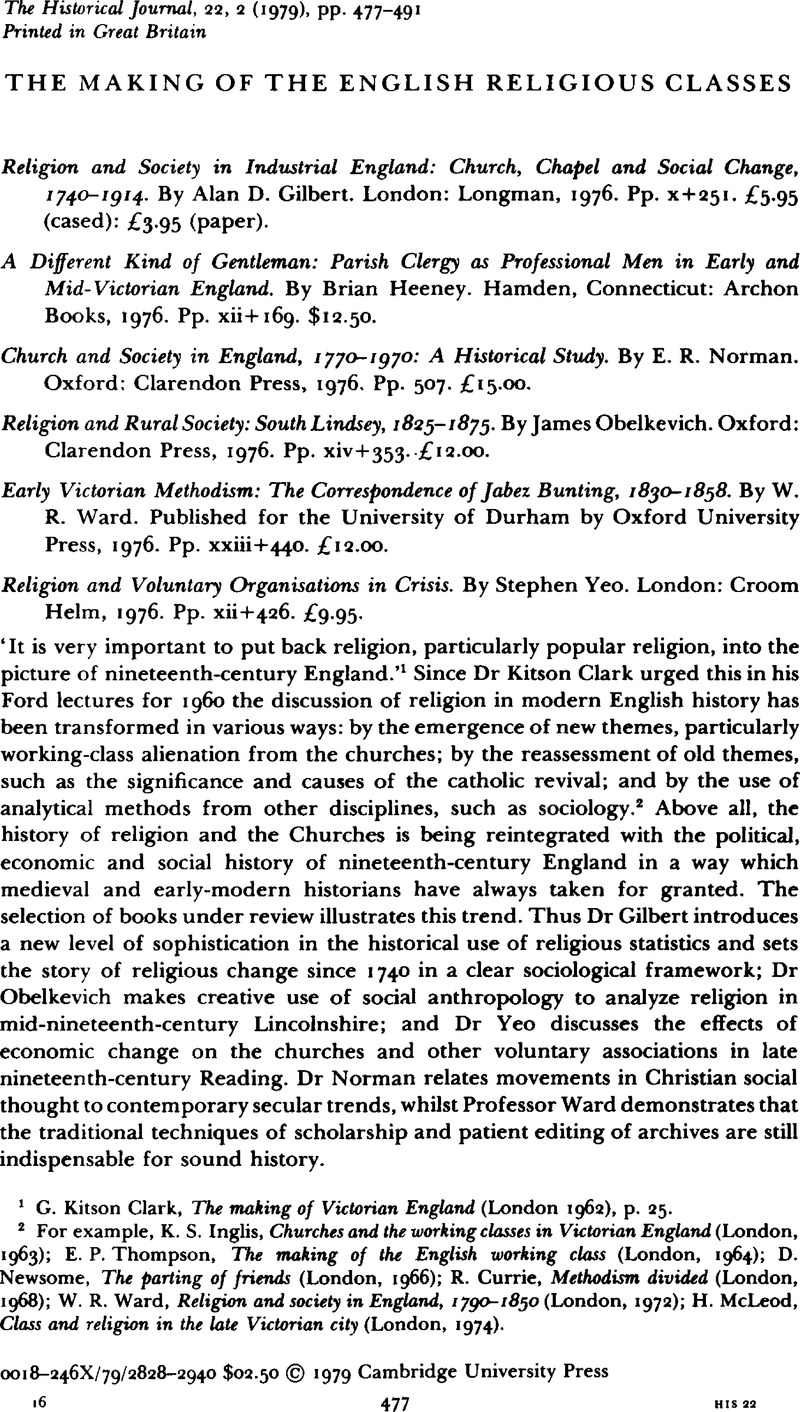Article contents
The Making of the English Religious Classes
Published online by Cambridge University Press: 11 February 2009
Abstract

- Type
- Review Articles
- Information
- Copyright
- Copyright © Cambridge University Press 1979
References
1 Clark, G. Kitson, The making of Victorian England (London 1962), p. 25Google Scholar.
2 For example, Inglis, K. S., Churches and the working classes in Victorian England (London, 1963)Google Scholar; Thompson, E. P., The making of the English working class (London, 1964)Google Scholar; Newsome, D., The parting of friends (London, 1966)Google Scholar; Currie, R., Methodism divided (London, 1968)Google Scholar; Ward, W. R., Religion and society in England, 1790–1850 (London, 1972)Google Scholar; McLeod, H., Class and religion in the late Victorian city (London, 1974)Google Scholar.
3 Kitson Clark, Making of Victorian England, pp. 21, 147 f.
4 Obelkevich, Religion and rural society, pp. 137–43: the quotation is from pp. 139–40.
5 Ibid, p. viii: the Report from the clergy of a district in the diocese of Lincoln (1800) on non-attendance at worship might have suggested that an agricultural county south of the Wash would have been a better case, cf. Soloway, R. A., Prelates and people (London, 1969), pp. 50–52Google Scholar.
6 12.0% as compared with 8.2%, though presumably Obelkevich's figure is a percentage of the total population, not the adult population as defined by Gilbert. Rough calculations suggest, however, that even if Obelkevich's figures were recalculated as percentages of the adult population, this would only mean that parishes with a population of below 200 were above Gilbert's national figure: Obelkevich, Religion and rural society, p. 139, Gilbert, Religion in industrial society, p. 28.
7 Is it the estimated nature of these figures which explains the curious dip in Anglican density in 1881, for which there is no comparable fluctuation in the ratio of churches or clergy to the adult population? In fact, the movements of the index between 1841 and 1881 are within 0.5% of the total range.
8 Ward, Bunting, p. 192.
9 Ward, Religion and society, pp. 97–104.
10 Ward, Bunting, pp. 154–5; Rogers, A., ‘The Victorian town and its region in nineteenth century religious history’ in Baker, D. (ed.), Studies in church history, XVI (Oxford, 1979)Google Scholar.
11 Ward, Bunting, pp. 323–8, 356–62.
12 Ibid. p. 405.
13 Ibid. p. 125 (March 1835).
14 Ibid. p. 309.
15 ibid. p. 285.
16 Ibid. p. 59: to James Kendall at the time of the Stephens case.
17 Ibid. pp. 282, 290, 316.
18 10 December 1856: quoted by Heeney, A different kind of gentleman, p. 31.
19 Heeney, A different kind of gentleman, pp. 108–9.
20 Jackson, J., Charge at his primary visitation, 1855 (London, 1855) p. 35Google Scholar: quoted by Obelkevich, Religion and rural society, pp. 172–3.
21 Henson, H. (ed.), Church problems (London, 1900), p. 21Google Scholar. Dr Norman's quotation from this passage (Church and Society, p. 2) ends with the sentence preceding the one quoted here.
22 The Conference on Christian politics, economics and citizenship (Birmingham, 1924).
23 This is one of a disconcerting number of small mistakes. Others include: the timing of the abolition of compulsory church rates (p. 216) and the terms of the University Tests Act, 1871 (p. 217); Westcott was never headmaster of Harrow (p. 181); Raven was never Lady Margaret Professor at Cambridge (p. 290); and the Gifford lectures are never given at Oxford (p. 328).
24 Vidler, A. R., ‘Westcott's Christian socialism’, in F. D. Maurice and company (London, 1966)Google Scholar.
25 Westcott, A., Life and letters of B. F. Westcott (London, 1903), 11, 198Google Scholar.
26 Tatlow, T., The story of the Student Christian Movement (London, 1933) p. 339Google Scholar. Thi s is also confused by an error in the date of the Matlock conference which first discussed social problems: this was in 1903, not 1913 as stated on page 236.
27 Smith, L. Adam, George Adam Smith (London, 1943), pp. 66–9, cf. pp. 112–13Google Scholar.
28 See, for example, his article in Theology for November 1939, and ‘What Christians stand for in the secular world’ (1944), reprinted in W. Temple (ed. A. E. Baker), Religious experience (London, 1958), pp. 243 f.
29 In his presidential address at the autumn assembly of the Baptist Union in 1888, ‘The new city of God: or the primitive Christian faith as a social gospel’, Baptist handbook, 1889 (London, 1889)Google Scholar.
30 Niebuhr, H. R., The social sources of denominationalism (New York, 1929)Google Scholar.
31 Moore, R., Pit-men, preachers and politics (Cambridge, 1974), p. 77Google Scholar.
- 1
- Cited by


